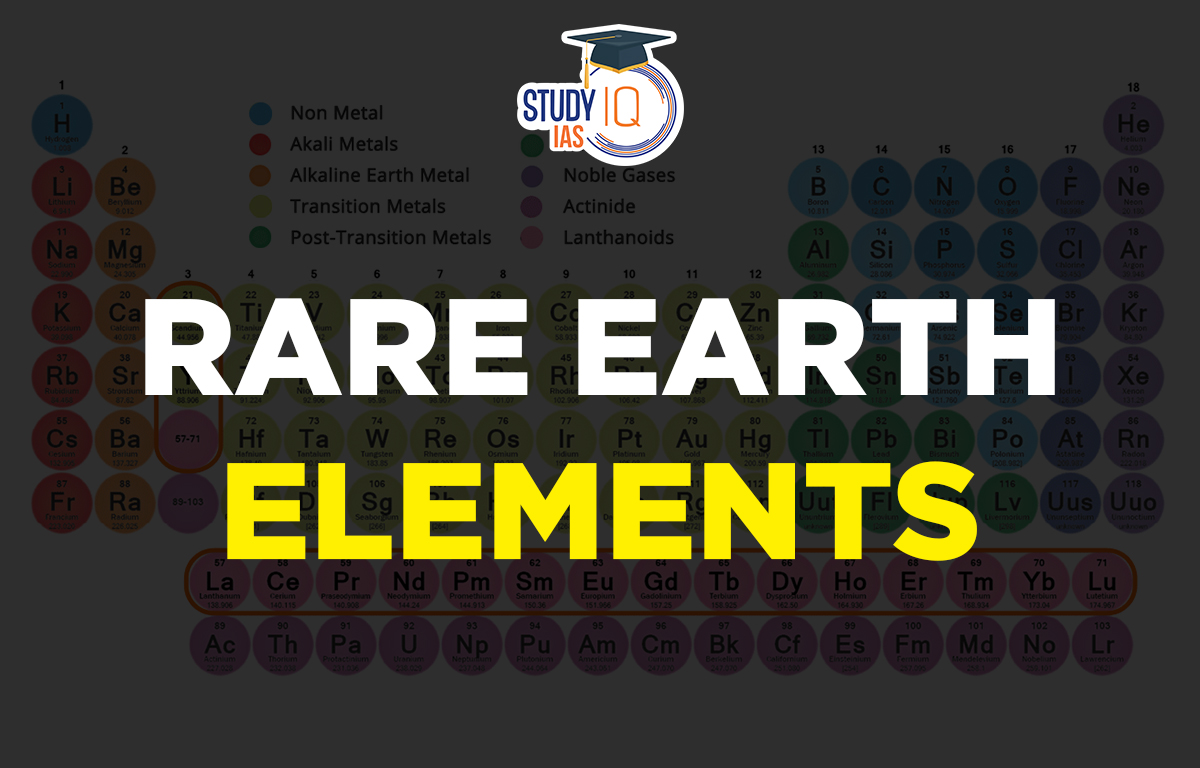Table of Contents
Context: Recently, China has suspended exports of several critical rare earth elements, metals and magnets in response to US Tariffs.
Rare Earth Elements (REE)
Rare Earth Elements (REE) are a group of 17 metals in Group 3 of the Periodic Table, including the Lanthanide series, Scandium, and Yttrium. Despite their name, they are common in nature but not available enough to be easily mined. India has the fifth-largest rare earth resource, mainly in its monazite minerals.
Rare Earth Metal is used in over 200 products, like consumer electronics, electric vehicles, and defence systems. The demand for rare metals is expected to grow, especially for renewable energy, electric vehicles, and sectors like communications and nuclear energy.
- China produces ~90% of the world’s rare earth elements (REEs).
- Highest Reserves Worldwide: (1) China (2) Brazil (3) India (4) Russia (5) Australia
What are Rare Earth Magnets?
- Rare earth magnets are strong permanent magnets made from rare earth elements, like neodymium, samarium and dysprosium.
- They are 10–20 times stronger than traditional magnets like ferrite or alnico.
Applications
- Electric motors: Used in hybrid vehicles and other applications requiring high efficiency.
- Generators: Used in wind turbines and other energy generation systems.
- Hard disk drives: Used in computer storage devices.
- Audio speakers: Enhancing sound quality and performance.
- Medical devices: Found in MRI machines and other imaging equipment.
- Defense: Used in precision-guided missiles, aircraft and electronic warfare systems.
What are Rare Earth Metals?
Rare Earth Metals are seventeen different metallic elements. These include the fifteen lanthanides on the periodic table, plus scandium and yttrium, which are similar to lanthanides. The seventeen rare earth elements are:
- Cerium (Ce)
- Dysprosium (Dy)
- Erbium (Er)
- Europium (Eu)
- Gadolinium (Gd)
- Holmium (Ho)
- Lanthanum (La)
- Lutetium (Lu)
- Neodymium (Nd)
- Praseodymium (Pr)
- Promethium (Pm)
- Samarium (Sm)
- Scandium (Sc)
- Terbium (Tb)
- Yttrium (Y)
Rare Earth Metals Properties
These minerals are used in many modern technologies like consumer electronics, computers, communications, health care, national defence, and clean energy because of their special magnetic, glowing, and electrochemical properties. Even future technologies need these rare earth elements (REEs).
For example, they are used in high-temperature superconductors and safe hydrogen storage for a future without fossil fuels. They are called “rare earth” because it was once hard to extract them from their oxide forms. Many minerals have them, but not in large enough amounts for easy commercial use.
Rare Earth Minerals Reserves
Major rare earth minerals found in India are Ilmenite, sillimanite, garnet, zircon, monazite, and rutile. These minerals are collectively known as Beach sand minerals (BSM). The fifth-largest reserves of rare earth minerals are found in India. Due to the radioactivity of monazite sands, Indian Rare Earths Ltd is the sole producer of rare earth compounds under the Department of Atomic Energy.
Globally, China has a monopoly on rare earth, following the United States’ withdrawal from this industry due to high environmental and health concerns. China once nearly paralysed the Japanese economy by suspending the export of rare earth elements. India also has critical rare earth minerals like zirconium, neodymium, and others, which are abundant in monazite sands. If used correctly, this could help Indian export markets.
However, the production of rare earth minerals has depleted over time due to a variety of factors such as cost reduction due to high production (economies of scale) in China, a lack of demand in the domestic market, and a lack of domestic processing technologies.
The majority of products containing rare earth minerals as raw materials are imported. Although rare earth minerals have a high value and add the potential for export growth, India has suffered due to inadequate processing technologies.
List of Rare Earth Elements and Their Applications
| Rare Earth Element | Present Applications |
| Yttrium |
|
| Lanthanum |
|
| Cerium |
|
| Praseodymium |
|
| Neodymium |
|
| Promethium |
|
| Samarium |
|
| Europium |
|
| Gadolinium |
|
| Terbium |
|
| Dysprosium |
|
| Holmium |
|
| Erbium |
|
| Thulium |
|
| Ytterbium |
|
| Lutetium |
|
Rare Earth Elements Trade and Production
- China has about one-third of the world’s rare earth element reserves.
- It controls 90% of the global rare earth market.
- Over time, China became the top producer of rare earth elements, once making 90% of the world’s supply.
- Now, China’s production has dropped to 60%, with other countries like Australia, India, Japan, and the United States making up the rest.
- Since 2010, when China stopped shipping rare earth elements to Japan, the US, and Europe, new production facilities have opened in Australia, the US, and smaller ones in Asia, Africa, and Latin America.
- Despite this, China still processes the most rare earth elements.
Rare Earth Elements Significance
- Rare earth materials are used in a wide variety of critical products, allowing many emerging green energy technologies, high-tech applications, and defence systems to function.
- They are found in consumer goods like smartphones, computer screens, and telescopic lenses.
- They use clean energy, which is essential in today’s world.
- Traditional applications include cerium for glass polishing and lanthanum for automotive catalysts or optical lenses.
- Rare earth minerals, such as neodymium, praseodymium, and dysprosium, are critical in the production of magnets used in industries such as electric vehicles, wind turbines, and drones in the twenty-first century.
Rare Earth Elements UPSC
Metals and non-metals that are regarded as critical for a country’s economic growth are known as essential minerals. Rare earth elements, such as gallium, manganese, aluminium, chromium, cobalt, and nickel, are found in important minerals. These minerals are essential for the rising high-tech industry. They play a critical role in the creation of a product. The economy and national security would suffer significantly without these minerals.
| Related Articles | |
| Manganese Ore | Cobalt Ore |
| Iron Ore | Minerals |
| Copper Ore | Precious Metals and Gems |
| Chromium Ore | Aluminium Ore |


 Iron Ore, Types, Uses, Distribution in I...
Iron Ore, Types, Uses, Distribution in I...
 Low Pressure System and Madden-Julian Os...
Low Pressure System and Madden-Julian Os...
 Largest Desert in the World, Check Name,...
Largest Desert in the World, Check Name,...





















